It had always fascinated me that my parents were once such eager travelers, because it was so at odds with who they had become.
My father began his career with an airline, and I suspect that one of the perks that my mother may have considered when marrying him was that it would come with a standing plane ticket. In those days, even lowly clerks were often rewarded with cheap or free seats when available, and it accounts for the fact that our family pictures included a good number of shots taken in faraway places.
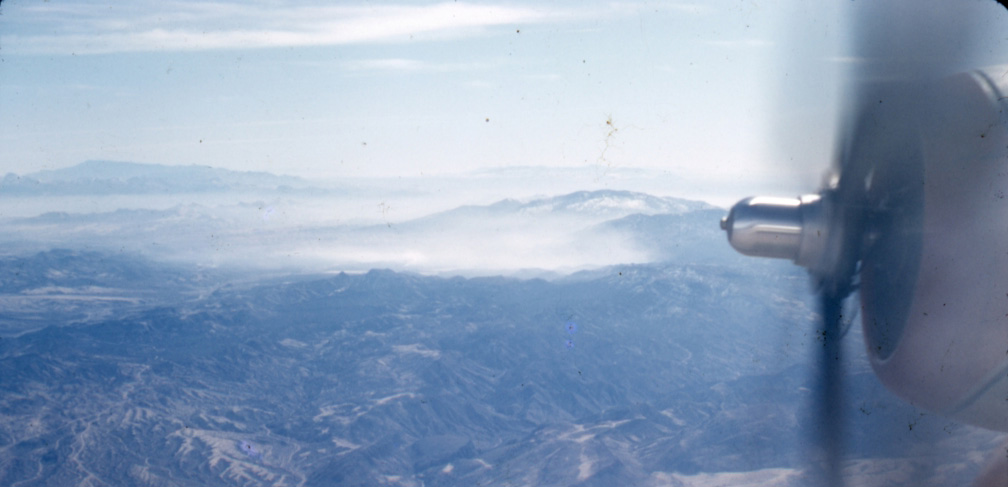
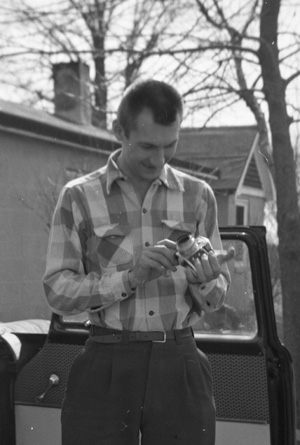
My father had a makeshift darkroom and a photo enlarger, and developed and printed many of his own photos. Judging from some of the negatives in his collection, he even seemed to have an inside line to a source of 35mm movie film, which he must have rolled into his own canisters for use in his camera. With his costs thus lowered, the number of photos he took must have been unusually high for the day. Yet they were still costly and inconvenient enough to be, as a rule, far better-composed than the casual, no-cost snapshots that accumulate on our iPhones today.
Unlike digital photography, analog photography presented the problem of retaining the context of each photo — the place, the event, and the date. Knowing the importance of metadata, he initially kept his photography carefully organized and labeled in indexed slide trays and albums. But having several children quickly put an end to that. By the time I was born, the darkroom had been decommissioned and his slide trays of color Kodachromes had achieved a completely random order due to our curiosity; most of the printed photos ended up loose, in a large box that we called “the picture box.”
Stories in snippets
Most of what I could visualize about my parents’ lives before the children arrived was thus conveyed to me through that picture box. It was a large corrugated-cardboard box, probably diverted from the trash, and it was filled with thousands of loose, mostly black-and-white photos, with obviously no organization present or possible. It was my father’s Photos app, but stuck in Slideshow mode and permanently set to Random Shuffle. Theoretically, this should have made me a marvelous Concentration or Matching Pairs player, because often the only way to locate a specific photo or to associate two photos as depicting scenes from the same event was to notice subtle similarities of the medium, in things like the paper on which they were printed, the style of their borders or edges, or a shared tonality or contrast — anything that seemed to suggest they might have been from the same roll of film or part of the same batch at the lab.
One of my favorite disjointed collections was from a trip to San Diego. I could group these together mentally from their borders and their surface texture, and because most had a handwritten note on the back, in the same hand and with the same pen. Photos from this trip and others to other parts of California and to Arizona, mostly in the 1950s, had long adorned the picture box, and reassured me that once, my homebody parents were quite well traveled, thank you, and had been to a lot of the important places. There were pictures of iconic things such as the handprints in the sidewalk at Grauman’s Chinese Theater, the locomotive at Knott’s Berry Farm, the dome at Palomar observatory, towering cactuses in the desert, and even of Jerry Lewis at a film set between takes, playing an impromptu game of touch football with Dean Martin, and sitting in a Cadillac looking grumpy until, in a later frame, a pair of adoring children engage him, reaching up admiringly to his window — and he suddenly lights up.
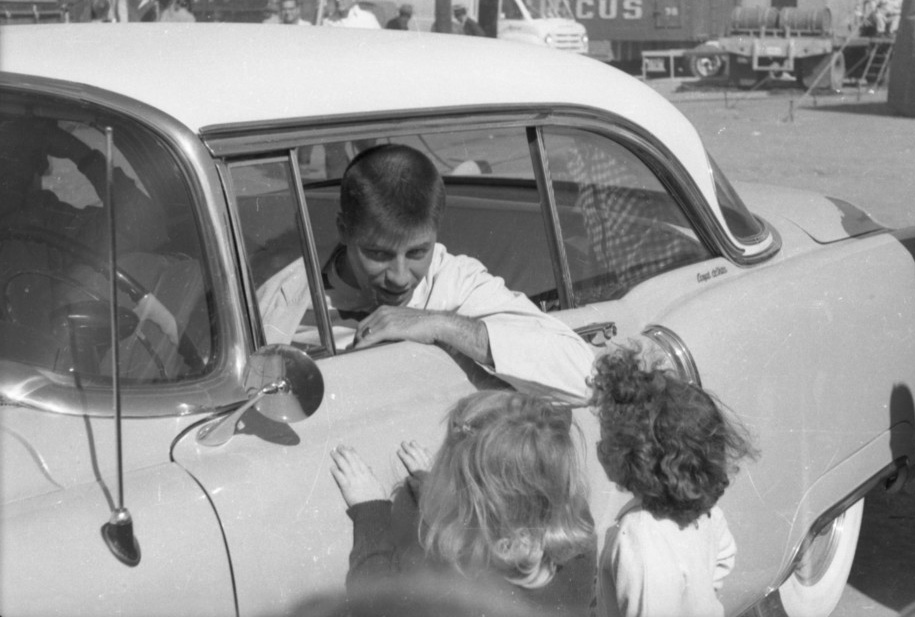
The light at the start of the tunnel
These fanciful travel photos were all from a certain brief period — between the dream of the honeymoon and the growing reality of the kids. I remember my mother saying that once, they had made a trip with my two oldest brothers, both still very young, and that the younger of the two had cried all the way. Not long after that, the photographic record indicates that their travels rapidly dropped off to nothing. By the time I came along (they had married very young, and I came very late), their horizon had folded upon itself until it stretched primarily between the shops and supermarkets of the two neighboring towns. While my father worked, my mother’s math and language skills, which I was told were rather prodigious in high school, found their mark in optimizing the yield of an insufficient budget, and in solving crossword puzzles, which were always solved completely. But this is not to suggest that this was necessarily a turn for the worse. Marrying and starting a family was of paramount importance among ordinary people in those days, and was the primary form of social wealth-building; in that sense, my parents were millionaires. As for us, we were all housed and healthy and loved, and we were not unlike the families of most of my classmates at school, except for our relative lack of spending money. Any shortcomings that might have existed in comparison to the standards of today could only be understood as first-world problems.
Putting things in order
Getting back to those photos of Jerry Lewis, the reason I could say “in a later frame” about one of them is because, after I inherited the entirety of the photo collection and my father’s early notes, I was able to put many of the picture box photos back into their original sequence. I could now assign dates, titles, and locations to many of the older Kodachromes, and could sort others using the frame numbers printed on the holders. Many of the picture box photos were represented by rolls of uncut negatives, allowing me to scan them anew in the same order in which they were taken. Seeing photos in their original shooting order restores context that can help identify who is in the picture and what is going on. In fact, in scanning the negatives I found that there were many images that he had never bothered to print, and which I was now seeing for the first time.

Loma de Oro
Among the slides was a gorgeous color Kodachrome, below, showing my still-teenage mother striking a pose on the doorstep of what I assumed was a motel of some sort, called Loma de Oro (meaning hill of gold, or golden hill). This group of photos was dated 1953 in my father’s notes, and associated with San Diego. So, this was a forgotten moment in that trip which had so long regaled me only with loose black-and-white prints — I now knew that it was the very first year of their marriage, and this must have been where they stayed. In fact, it was — once I correlated the frame number with my father’s slide index, the note for that frame said simply, “Where we stayed”.
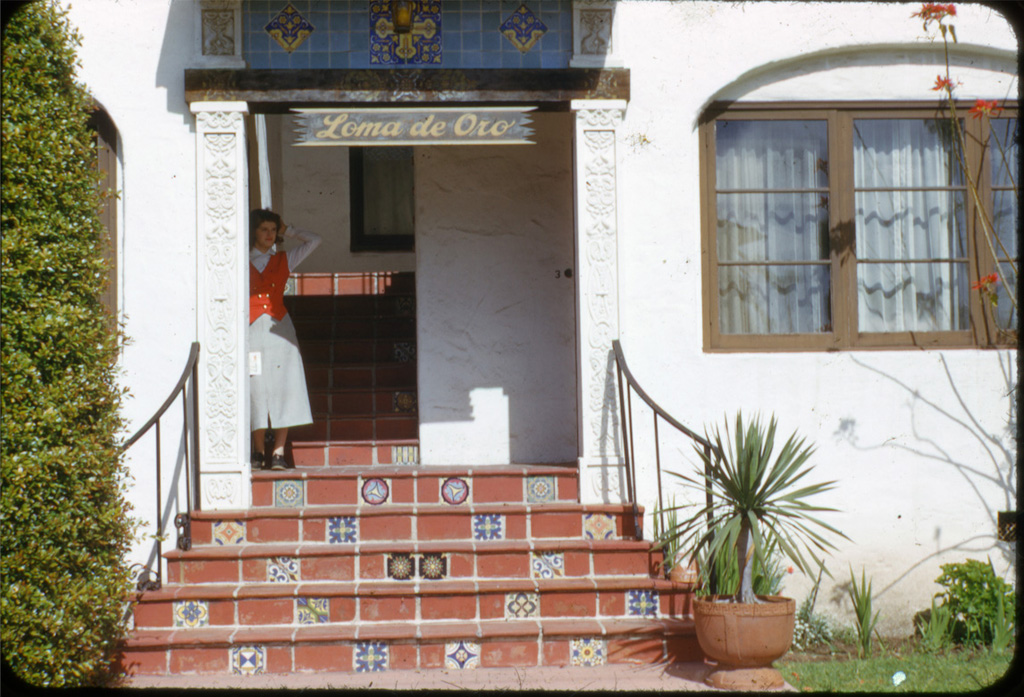
“Loma de Oro” was an unusual enough name that I gave a shot at identifying the exact place. The internet told me that, sure enough, there was a Loma de Oro in San Diego, today — but it was an apartment building, not a motel. I looked it up anyway. In satellite images, it looked plausible that it could be the same building in the photo. Street View confirmed it. I never knew that they had stayed at an apartment building, which seems unusual for a short trip. Since this was long before AirBnB, I can only assume that they had friends there, with whom they were staying.
Fast forward
In 2017, I found myself attending a conference in San Diego. Now, if I wanted, I could actually visit the spot. So one morning, during an empty time in the conference, I set out on a surgical trip to the site. I got on the train from my hotel at the conference venue, and made my way to a stop at Golden Hill, caught a bus, and then walked the rest of the way. Yes, it was there, and it was remarkably unchanged after 64 years.
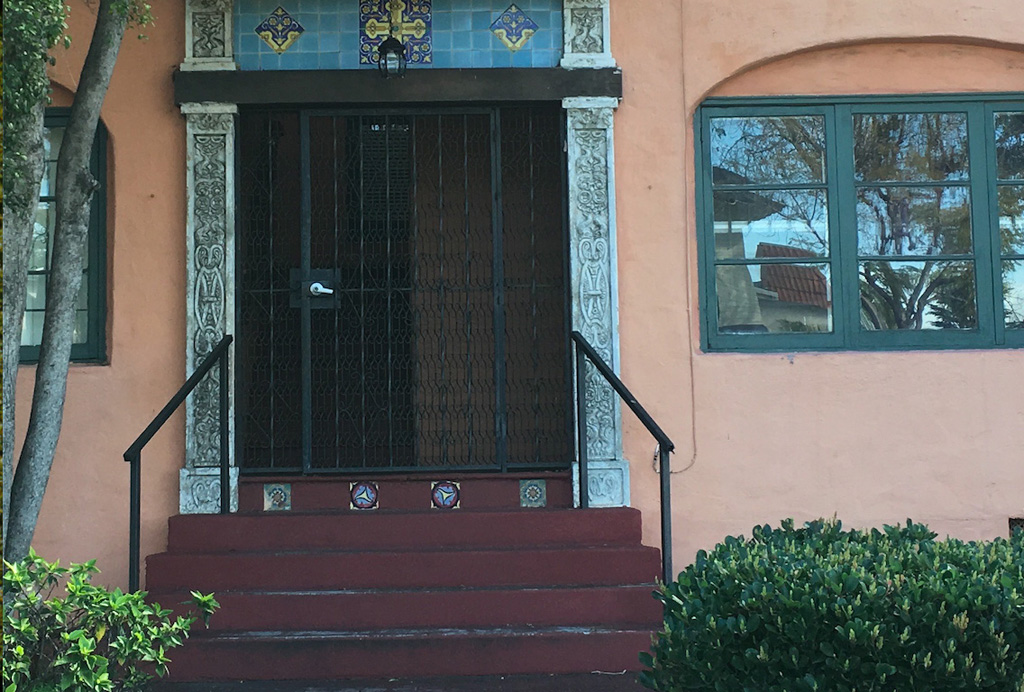
Analyzing these two photos, we could be tempted to draw some implications about the arc of society over these six decades. The white-washed walls are now a more colorful peachy tint; the tiles on the steps, with the exception of those on the topmost riser, are gone, with painted concrete now passing as sufficient. The graceful railings have been replaced with straight, workmanlike members, and have been brought inward to meet the doorway opening, perhaps to conform with some safety code. And a steel gate, preventing intrusion, also prevents someone like my mother from striking the same pose for her new husband, today. Perhaps the gate also displaced the artfully rustic “Loma de Oro” sign. Interestingly though, the windows might still be the same. In such a mild climate, there probably hasn’t been much impetus to replace classic old wavy-glass windows with clumsy thermal-pane replacements.
Down the rabbit hole
The experience was much like stepping into a photograph. I could look around and see what, perhaps, my parents had seen but which to me had always been just outside the viewfinder. I had never known that to the left of my father’s camera was a picturesque staircase, nor that he was standing on a sidewalk along a residential street. To his right, there was a busy intersection, where several shops and restaurants whose buildings certainly date to the period still remain, and where they might have shopped or dined.
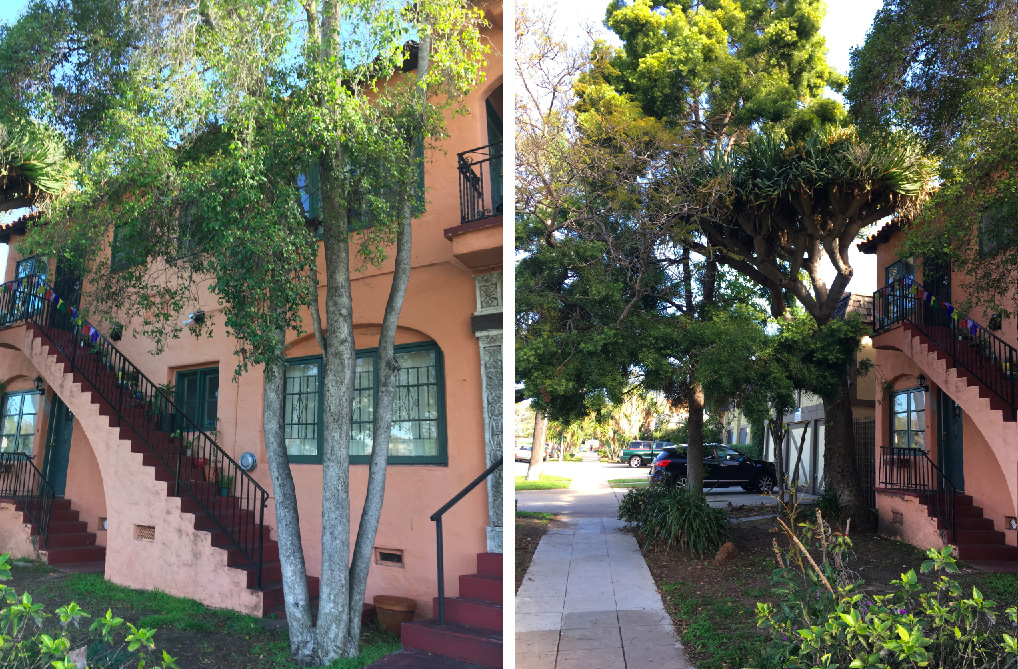
And were these, today, the same sidewalks? Probably. Much of the sidewalk on this block consists of flagstones in a somewhat distinctive, three-abreast pattern. While there were some repairs here and there, it was likely the same walk. The key clue was the date stamps found on this walk and around the corner, which suggest that this pattern of paving goes back a long time. Whether or not the specific flagstones my father stood upon were still there, the two of them must have tread upon many of those that remain.

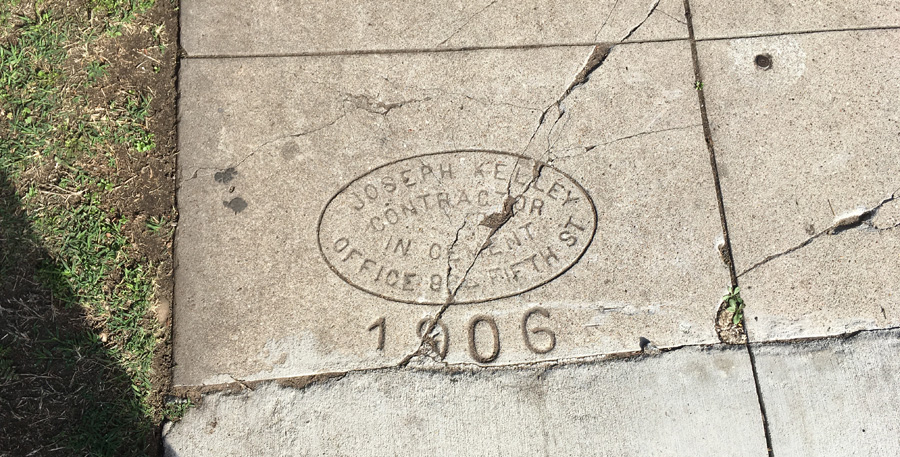
In essence, every time my family members sifted through our hoard of randomized photos, it was an attempt to step into one or another photograph. Here, I came as close as anyone might ever hope to do.
Faced with the puzzle of the picture box, much of my childhood was spent viewing the arc of my relatives’ lives, expressed as a jumble of juxtaposed moments having no apparent temporal, spatial, or causal relation to each other except through their depiction of the same set of characters and their presence in the same box. Through random pairings and sequencings that their subjects never could have anticipated, these images reflected upon and refracted through each other, causing unrelated events to confront each other in a way that perhaps provided a greater sense of the whole.
Two years later, I found myself in San Diego again. I briefly flirted with the idea of a side trip to Palomar, to see if I could duplicate that picture of the observatory. But I found that my earlier quest to the Loma de Oro had been enough. I had learned a little bit more about a moment in my parents’ lives, but I felt that now I was beginning to pry. The photos were for us, but that trip was still theirs, and I let them have it to themselves again.
On my last evening, I simply took a walk from my hotel to the shoreline, with a wee drink in my thermos, and thought about the conference, and tomorrow’s trip home.
Article and photos Copyright 2021 by the author.
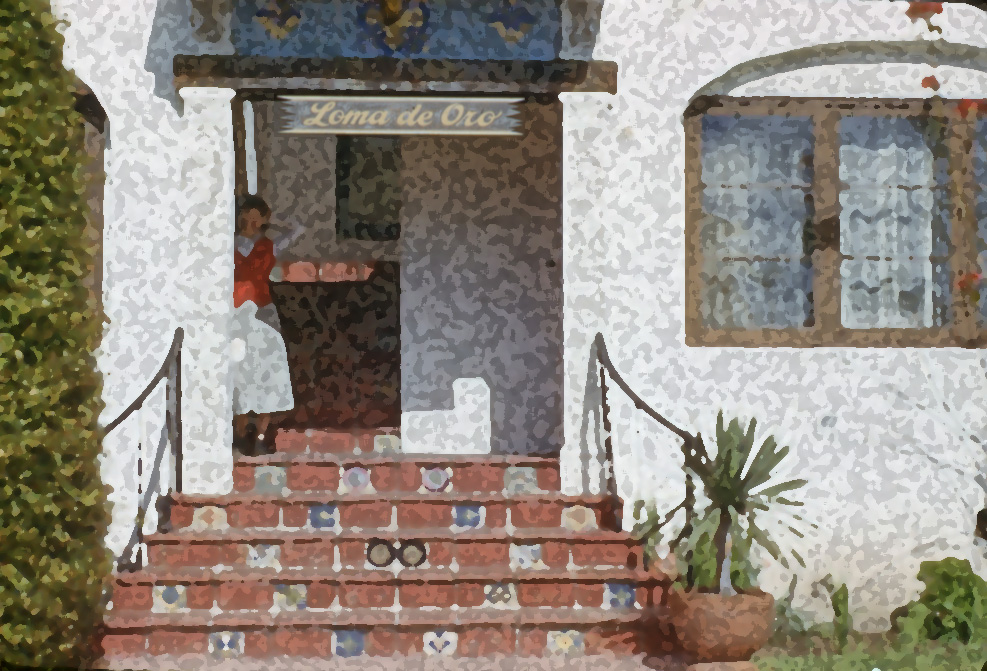


One Comment
Pingback: